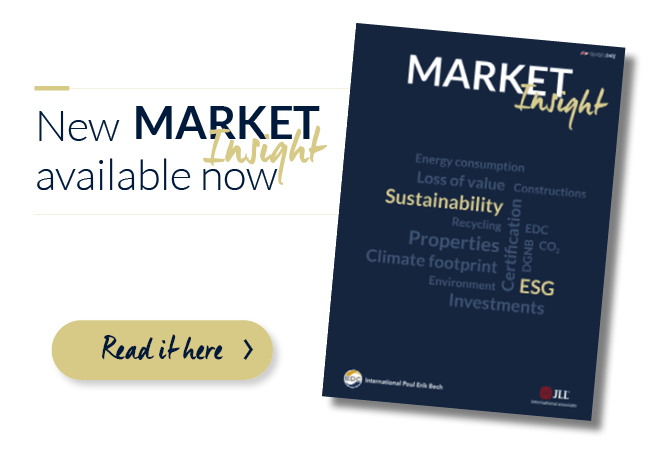Multi-user office buildings are gaining popularity: Energy renovation of a commercial property of 6,000 sqm in Roskilde
A multi-user office building at Ringstedvej 16-28 in Roskilde has been energy-renovated into a healthy office building with a better energy class, and soon also the sustainability designation ‘DGNB BIU-Gold’. The property contains up to 12 modern leases for rent on three floors. Jacob Østergaard Skyum, Senior Asset Manager at PenSam, says:
“It has previously been a headquarter property, but when the latest headquarter tenant, Orbicon, vacated, we explored different possibilities for sales, conversion to residential, or conversion to a multi-user office building. Ultimately, we chose to convert it into a multi-user office building because renting out smaller units than all 6,000 sqm to one company is easier. It is often obvious, but it was obvious here because it was a plug & play solution, due to the property’s three separate entrances. This implies that companies feel that their customers and partners visit their company exclusively, and the rentals have also been shown to have gone really well.”
“We have energy-renovated the property with new cooling/ventilation, energy controlling measures and removed a large part of the existing interior. When a new tenant arrives, we will closely discuss interior design wishes. This means that we have attracted many strong tenants, with several of them on 10-year lease agreements, and for us, it is important to have good, long-term collaborative relationships. We have invested significant resources in the property, but it has gone relatively quickly, so we have rented out almost everything in less than a year. This is satisfying, and even though it is a big investment, the property will give us a good return.”
The seven new tenants are: Kronjylland Savings Bank, plastic surgeons Horn & Gramkow, Children’s House Zealand, office hotel Væxthuset, a specialist dentist, an oral surgeon, and the consultancy firm QV Compliance. There are three remaining leases of 410, 621 and 621 sqm.
Strong sustainability profile
PenSam has a sustainability strategy involving the certification of a large part of their properties and with a declared goal that by the end of 2025, they should have reduced their total CO2 emissions by 50%. Jacob Østergaard Skyum from PenSam says:
“We certify all of our new builds for sustainability, but one thing is new buildings, and another is the existing building stock. A newly built property is built to contemporary and energy-efficient standards. Therefore, there are fewer improvement opportunities to work with, even though the building will have to stand for many years before the overall CO2 account is settled due to the embedded CO2 from the construction. On the other hand, there are many opportunities to create positive development on existing buildings, and if we are to reverse the trend and reduce the CO2 footprint truly, we must act. We have gone from energy class C to energy class B on the property, and we hope to reach energy class A with further initiatives.”
“We have a strong sustainability profile in PenSam. When we renovate our buildings, we must at least improve the energy class by one. The initiatives on the property have substantially reduced annual CO2 emissions of almost 7 tons here in Roskilde. We have optimized cooling/ventilation, which provides a healthy building with a good indoor climate and introduced energy management measures that reduce consumption. We have also implemented several measures so that the building can achieve the sustainability certification ‘DGNB BIU-Gold,’ which is the certification for existing buildings. We will also soon have charging stations for electric cars in our parking lot. We have gradually put all these things in place, and in fact, we have not even had time to promote the building’s sustainability before the leases were almost filled.”
Multi-user buildings are popular
John Borrisholt, Regional Director of Zealand and partner at EDC Erhverv Poul Erik Bech Roskilde, has facilitated several of the leases and says: “In addition to energy optimization and sustainability, PenSam’s multi-user office is a good example of a trend we see throughout Denmark. It is more difficult to lease large office spaces to just one company, so we often advice clients to divide the property into several units, as it is easier to attract several small and medium-sized companies that can share office facilities.”
Alexander Wenzel, commercial advisor at EDC Erhverv Poul Erik Bech Roskilde, adds: “The property is also a good example of the healthy rental market in Roskilde. In general, there is demand for both larger and smaller leases, and the vacancy rate is not very high for office spaces. Out of the total 6,000 m², there is now only about 1,600 m² left, where we are in dialogue with several interested parties.”
Regarding EDC Erhverv Poul Erik Bech’s role, Jacob Østergaard Skyum, PenSam, says: “When we first decided on a multi-user building, we went all in on strategy and marketing, and it has worked impeccably. There has been an excellent dialogue with John and Alexander from EDC, where we, together with DEAS and our construction consultant, have held briefings every 14 days to give status updates. As an experienced man like John, we naturally expect him to deliver and help find tenants. Still, I would also like to highlight Alexander, who has been proactive, shown great engagement and initiative, and found several tenants, so it has been an outstanding job. I would definitely describe the case as a success story.”
Find the case at www.edc.dk/40302280
